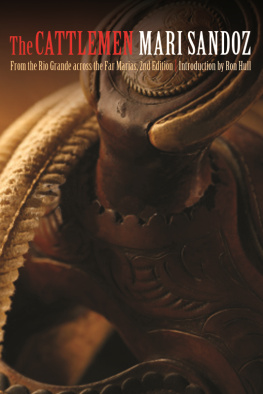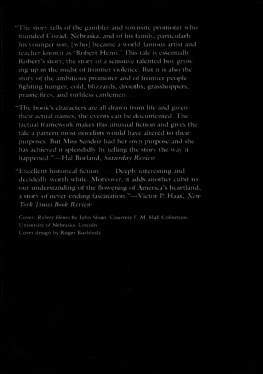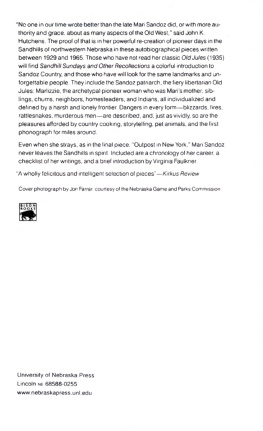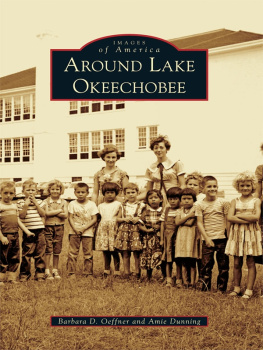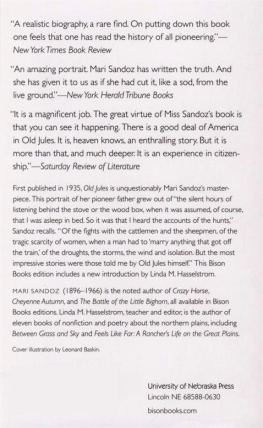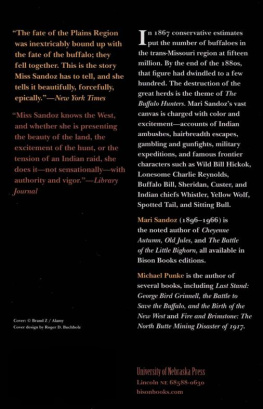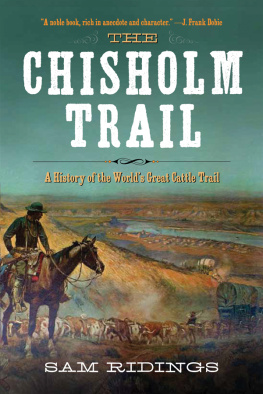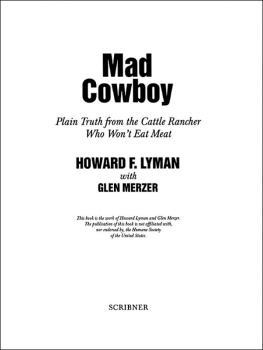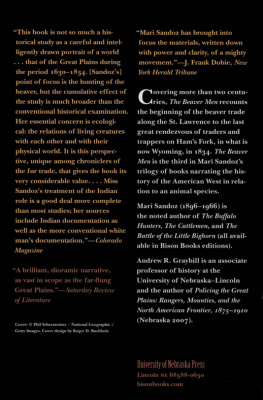Sandoz - Cattlemen
Here you can read online Sandoz - Cattlemen full text of the book (entire story) in english for free. Download pdf and epub, get meaning, cover and reviews about this ebook. year: 1957, publisher: UNP - Bison Books, genre: Adventure. Description of the work, (preface) as well as reviews are available. Best literature library LitArk.com created for fans of good reading and offers a wide selection of genres:
Romance novel
Science fiction
Adventure
Detective
Science
History
Home and family
Prose
Art
Politics
Computer
Non-fiction
Religion
Business
Children
Humor
Choose a favorite category and find really read worthwhile books. Enjoy immersion in the world of imagination, feel the emotions of the characters or learn something new for yourself, make an fascinating discovery.
Cattlemen: summary, description and annotation
We offer to read an annotation, description, summary or preface (depends on what the author of the book "Cattlemen" wrote himself). If you haven't found the necessary information about the book — write in the comments, we will try to find it.
The Cattlemen is the story of the cattle industry in America and of the men whose ranches reached from the Rio Grande into Montana, from the early Spanish days to Mari Sandozs contemporary times. It is the second in Sandozs trilogy of books narrating the history of the American West in relation to animal species.
Sandoz: author's other books
Who wrote Cattlemen? Find out the surname, the name of the author of the book and a list of all author's works by series.
Cattlemen — read online for free the complete book (whole text) full work
Below is the text of the book, divided by pages. System saving the place of the last page read, allows you to conveniently read the book "Cattlemen" online for free, without having to search again every time where you left off. Put a bookmark, and you can go to the page where you finished reading at any time.
Font size:
Interval:
Bookmark:
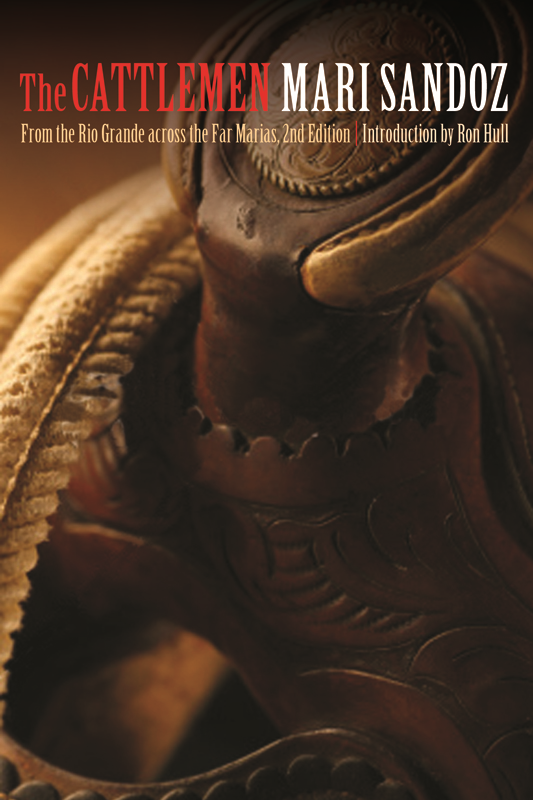
Books by Mari Sandoz published by
The University of Nebraska Press
The Battle of the Little Bighorn
The Beaver Men: Spearheads of Empire
The Buffalo Hunters: The Story of the Hide Men
Capital City
The Cattlemen: From the Rio Grande across the Far Marias
Cheyenne Autumn
The Christmas of the Phonograph Records
Crazy Horse: The Strange Man of the Oglalas
The Horsecatcher
Hostiles and Friendlies: Selected Short Writings of Mari Sandoz
Letters of Mari Sandoz
Love Song to the Plains
Miss Morissa: Doctor of the Gold Trail
Old Jules
Old Jules Country
Sandhill Sundays and Other Recollections
Slogum House
Son of the Gamblin' Man: The Youth of an Artist
The Story Catcher
These Were the Sioux
The Tom-Walker
Winter Thunder
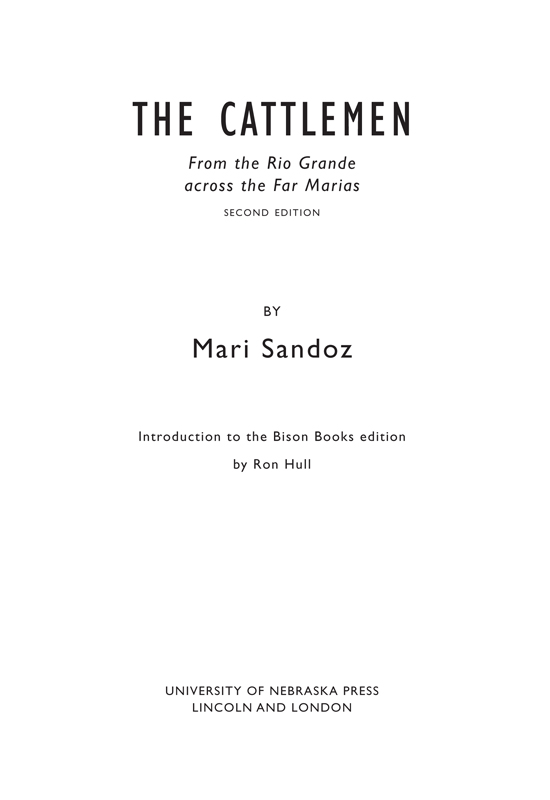
1958 by Mari Sandoz
Introduction 2010 by the Board of Regents of the University of Nebraska All rights reserved
Manufactured in the United States of America

First Nebraska paperback printing: 1978
Reprinted by arrangement with the Estate of Mari Sandoz, represented by Mcintosh and Otis, Inc.
Library of Congress Cataloging-in-Publication Data Sandoz, Mari, 1896-1966.
The cattlemen: from the Rio Grande across the far Marias / Mari Sandoz; introduction to the Bison Books edition by Ron Hull.2nd ed.
p. cm.
Includes bibliographical references and index.
ISBN 978-0-8032-4376-7 (pbk.: alk. paper)
1. Frontier and pioneer lifeWest (U.S.) 2. Ranch lifeWest (U.S.)History.
3. PioneersWest (U.S.)History. 4. RanchersWest (U.S.)History. 5. Cattle
tradeWest (U.S.)History. 6. West (U.S.)History1860-1890. 7. West
(U.S.)History1890-1945. 8. West (U.S.)History1945- 9. West (U.S.)
Social life and customs. I. Title.
F596.S212 2010
978'.02dc22 2009048982
E-book ISBN: 978-0-8032-4599-0
Ron Hull
In the early 1960s on the mantelpiece of the faux fireplace in Mari Sandoz's apartment at 422 Hudson Street in New York City's West Village stood a statuette of a thin, hipless, gaunt, lanky ranch hand. This realistic portrayal of the "cow hand" was one of the many awards marking her publishing achievements. As I admired it, Mari Sandoz, sitting in her favorite wingback chair (where through the years she began in longhand many first drafts of her work), looked at me and said, "That's the kind of man I like." Looking at her I knew that she meant it.
Growing up in the high plains country of northwest Nebraska, Mari Sandoz knew this man, his dreams, his independent spirit, his people, and the intricate details of the cattlemen's history he helped create. This region at the turn of the twentieth century was a harsh environment, and it was settled by tough, courageous, persistent, and determined people who had to overcome the blizzards, draughts, searing heat, prairie fires, grasshopper plagues, lawless elements in the population, and years and years of subsistence living.
She was the eldest daughter of Jules Sandoz, whom she immortalized in Old Jules, considered by many the definitive story of homesteading on the Great Plains. Though her father was often a cruel and violent man, he also helped many settlers in the region and brought a wide range of fascinating people to the modest Sandoz house on the Niobrara River. It was here, as a child, that this plain, skinny daughter of Old Jules sat in the corner and heard with insatiable curiosity the tales of the cattlemen, the farmers, the adventurers, and it was here that she began to understand the people and the land of the high plains country and to write her own stories.
Mari Sandoz encouraged people to write. Her mantra was: "Anyone with the power of literacy can learn how to write well enough to publish." In her teaching and her lectures she told people that it is important to work in a field with which you have strong emotional identity, with material that means something to you personally. Throughout her distinguished publishing career she followed her own advice. She knew firsthand the people she was writing about.
Though she did not consider herself one of the very, very gifted writers, she wanted to be acknowledged as both a significant research person and a creative writer. She said, "Geniuses often don't know where their material comes from." This was not her case. Her work was a very practical kind of writing that took months, even years, of careful research, as well as interviews, observation of locales, writing, rewriting, throwing great sections away, and starting all over again. She refined, she polished, she reworked every paragraph, line, sentence, and word she put to paper. Supporting every word, thought, or description were her diligent, persistent years of research of the Trans-Missouri Region.
I was working with Sandoz while she was accomplishing her research for The Battle of the Little Bighorn, her last major book, published posthumously in 1966. She recounted to me that while working on the material of the battlefield, she would take a commercial bus early in the morning that let her off some three miles from the site. Carrying her lunch with her, she walked over to where the battle took place, settled herself on the ground, and with pencil in hand made notes about every aspect of the area around her-staying all day, observing, studying the hills and every dimension of this locale. She wrote detailed sketches of the trees and bushes, the rock formations and rocks on the ground. She noted the sky, the position of the clouds, any wild animals that came within her range; she studied the grasses and the weeds and the flowers, moving here and there over the landscape, absorbing every detail of the place. When the sun began to go down, she knew she had to walk back the three or so miles to catch the bus and return to where she was staying. This she did for a number of days, until she was satisfied that she had intimate, firsthand knowledge of this historic place and could create accurate mind pictures for the reader of where Custer and his men met defeat.
The following passage from The Cattlemen is evidence of this kind of painstaking research and the lifelong accumulation of knowledge she brought to her writing:
The region was without a rock or tree or even a shrub beyond a few little buckbrush patches or perhaps a dwarf willow shorter than the stirrup, in some low spot. The only thorns to make the Texans feel at home were those on the low clumps of re-hipped prairie roses in the grass, the spears of the soapweed clumps on the sandier knobs, and an occasional patch of bull-tongue cactus-patches like greenish hearthrugs scattered around, the sections small and dainty to the eye accustomed to prickly pear that grew taller than a man on horseback, with the gray-blue sections over a foot long, the barbed spines the size of darning needles.
She had an accurate, expert eye in discerning the details of the high plains country, and she had the literary ability to paint these pictures for us indelibly.
Mari Sandoz had an ambitious dream. When she was twenty-one years old she made up her mind that she would make a six-book study-a nonfiction narrative of modern man's incumbency on the stone age era, then on to the iron age, and on up to the present. She chose geographically the Great Plains, or the Trans-Missouri Region, as she referred to it. As she said, "Through the discovery of this region, this one drop of water, I hope to discover something of the nature of the ocean."
Font size:
Interval:
Bookmark:
Similar books «Cattlemen»
Look at similar books to Cattlemen. We have selected literature similar in name and meaning in the hope of providing readers with more options to find new, interesting, not yet read works.
Discussion, reviews of the book Cattlemen and just readers' own opinions. Leave your comments, write what you think about the work, its meaning or the main characters. Specify what exactly you liked and what you didn't like, and why you think so.

